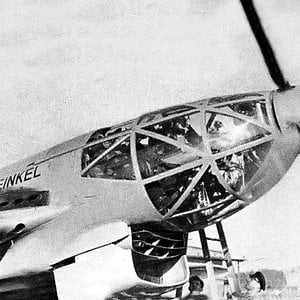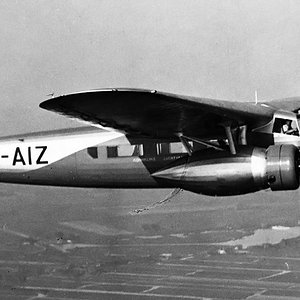Navigation
Install the app
How to install the app on iOS
Follow along with the video below to see how to install our site as a web app on your home screen.
Note: This feature may not be available in some browsers.
More options
You are using an out of date browser. It may not display this or other websites correctly.
You should upgrade or use an alternative browser.
You should upgrade or use an alternative browser.
In the 1930s, brothers Siegfried and Walter Günter were pushing the limits of aerodynamics as they designed aircraft for Heinkel Flugzeugwerke in Germany. Perhaps the ultimate expression of their aerodynamic beliefs was the Heinkel He 119. The Günter brothers and Ernest Heinkel envisioned the He 119 as an unarmed, high-speed reconnaissance aircraft or light bomber.
Heinkel He 119 V1 prototype with the hastily installed radiator to augment the evaporate cooling system.
Work on the He 119 began in the summer of 1936 as a private venture funded by Heinkel Flugzeugwerke. The aircraft appeared to have a fairly standard layout as an all metal, low-wing monoplane with retractable gear. However, the very streamlined fuselage hid the He 119’s unorthodox power arrangement. To achieve the low-drag necessary for high-speed operations, the engine was buried in the fuselage, just behind the cockpit and above the wings. An enclosed drive shaft extended forward from the engine, through the cockpit, between the pilot and co-pilot, and to the front of the aircraft where it drove a 14 ft (4.27 m), metal, variable-pitch, four-blade propeller.
No engine produced the power needed for the He 119, so two Daimler-Benz DB 601 engines were placed side-by-side and coupled together through a common gear reduction. The DB 601 was a liquid-cooled, 12-cylinder, 60 degree, inverted Vee engine with a 5.91 in (150 mm) bore and 6.30 in (160 mm) stroke. When coupled, the 24-cylinder engine was known as the DB 606; it displaced 4,141 cu in (67.8 L) and produced 2,350 hp. The inner banks of the DB 606 were pointed nearly straight down and exhausted under the aircraft. The side banks’ exhaust was expelled just above the He 119’s wings.
Specifications (He 119 V6)
Data from Warplanes of the Third Reich[1]
General characteristics
Crew: 3
Length: 14.80 m (48 ft 6½ in)
Wingspan: 15.90 m (52 ft 2 in)
Height: 5.40 m (17 ft 8½ in)
Wing area: 50.02 m² (538.2 ft²)
Empty weight: 5,201 kg (11,464 lb)
Loaded weight: 7,581 kg (16,678 lb)
Powerplant: 1 × Daimler-Benz DB 606A-2 24-cylinder liquid cooled coupled engine, 1,753 kW (2,350 hp)
Performance
Maximum speed: 591 km/h (319 knots, 367 mph) at 4,500 m (14,765 ft)
Cruise speed: 510 km/h (276 knots, 317 mph) at 4,500 m (14,765 ft) (60% power)
Range: 3,123 km (1,687 nmi, 1,940 mi) at 6,000 m (19,685 ft)
Service ceiling: 8,500 m (27,890 ft)
Climb to 2,000 m (6,560 ft): 3.1 min
Climb to 4,500 m (19,685 ft): 10.7 min
Armament
Guns: 1 × 7.9 mm (.312 in) MG 15 machine gun in dorsal position
Heinkel He 119 V1 prototype with the hastily installed radiator to augment the evaporate cooling system.
Work on the He 119 began in the summer of 1936 as a private venture funded by Heinkel Flugzeugwerke. The aircraft appeared to have a fairly standard layout as an all metal, low-wing monoplane with retractable gear. However, the very streamlined fuselage hid the He 119’s unorthodox power arrangement. To achieve the low-drag necessary for high-speed operations, the engine was buried in the fuselage, just behind the cockpit and above the wings. An enclosed drive shaft extended forward from the engine, through the cockpit, between the pilot and co-pilot, and to the front of the aircraft where it drove a 14 ft (4.27 m), metal, variable-pitch, four-blade propeller.
No engine produced the power needed for the He 119, so two Daimler-Benz DB 601 engines were placed side-by-side and coupled together through a common gear reduction. The DB 601 was a liquid-cooled, 12-cylinder, 60 degree, inverted Vee engine with a 5.91 in (150 mm) bore and 6.30 in (160 mm) stroke. When coupled, the 24-cylinder engine was known as the DB 606; it displaced 4,141 cu in (67.8 L) and produced 2,350 hp. The inner banks of the DB 606 were pointed nearly straight down and exhausted under the aircraft. The side banks’ exhaust was expelled just above the He 119’s wings.
Specifications (He 119 V6)
Data from Warplanes of the Third Reich[1]
General characteristics
Crew: 3
Length: 14.80 m (48 ft 6½ in)
Wingspan: 15.90 m (52 ft 2 in)
Height: 5.40 m (17 ft 8½ in)
Wing area: 50.02 m² (538.2 ft²)
Empty weight: 5,201 kg (11,464 lb)
Loaded weight: 7,581 kg (16,678 lb)
Powerplant: 1 × Daimler-Benz DB 606A-2 24-cylinder liquid cooled coupled engine, 1,753 kW (2,350 hp)
Performance
Maximum speed: 591 km/h (319 knots, 367 mph) at 4,500 m (14,765 ft)
Cruise speed: 510 km/h (276 knots, 317 mph) at 4,500 m (14,765 ft) (60% power)
Range: 3,123 km (1,687 nmi, 1,940 mi) at 6,000 m (19,685 ft)
Service ceiling: 8,500 m (27,890 ft)
Climb to 2,000 m (6,560 ft): 3.1 min
Climb to 4,500 m (19,685 ft): 10.7 min
Armament
Guns: 1 × 7.9 mm (.312 in) MG 15 machine gun in dorsal position








